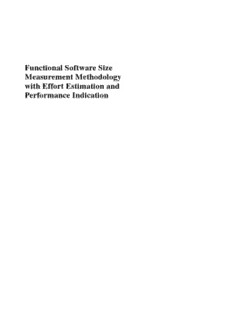
Functional Software Size Measurement Methodology with Effort Estimation and Performance Indication PDF
Preview Functional Software Size Measurement Methodology with Effort Estimation and Performance Indication
Functional Software Size Measurement Methodology with Effort Estimation and Performance Indication IEEEPressEditorialBoard TariqSamad,EditorinChief GiancarloFortino XiaoouLi RayPerez DmitryGoldgof AndreasMolisch LindaShafer DonHeirman SaeidNahavandi MohammadShahidehpour EkramHossain JeffreyNanzer ZidongWang AboutIEEEComputerSociety IEEEComputerSocietyistheworld’sleadingcomputingmembershiporganizationand thetrustedinformationandcareer-developmentsourceforaglobalworkforceoftech- nologyleadersincluding:professors,researchers,softwareengineers,ITprofessionals, employers, and students. The unmatched source for technology information, inspira- tion, and collaboration, the IEEE Computer Society is the source that computing pro- fessionals trust to provide high-quality, state-of-the-art information on an on-demand basis. The Computer Society provides a wide range of forums for top minds to come together, including technical conferences, publications, and a comprehensive digital library, unique training webinars, professional training, and the TechLeader Training Partner Program to help organizations increase their staff’s technical knowledge and expertise, as well as the personalized information tool myComputer. To find out more aboutthecommunityfortechnologyleaders,visithttp://www.computer.org. IEEE/WileyPartnership TheIEEEComputerSocietyandWileypartnershipallowstheCSPressauthoredbook programtoproduceanumberofexcitingnewtitlesinareasofcomputerscience,com- puting,andnetworkingwithaspecialfocusonsoftwareengineering.IEEEComputer Society members continue to receive a 15% discount on these titles when purchased throughWileyoratwiley.com/ieeecs. Tosubmitquestionsabouttheprogramorsendproposals,pleasecontactMaryHatcher, Editor, Wiley-IEEE Press: Email: [email protected], Telephone: 201-748-6903, JohnWiley&Sons,Inc.,111RiverStreet,MS8-01,Hoboken,NJ07030-5774. Functional Software Size Measurement Methodology with Effort Estimation and Performance Indication Jasveer Singh Copyright©2017bytheIEEEComputerSociety,Inc.Allrightsreserved. PublishedbyJohnWiley&Sons,Inc.,Hoboken,NewJersey. PublishedsimultaneouslyinCanada. Nopartofthispublicationmaybereproduced,storedinaretrievalsystem,ortransmittedinanyformorbyany means,electronic,mechanical,photocopying,recording,scanning,orotherwise,exceptaspermittedunder Section107or108ofthe1976UnitedStatesCopyrightAct,withouteitherthepriorwrittenpermissionofthe Publisher,orauthorizationthroughpaymentoftheappropriateper-copyfeetotheCopyrightClearanceCenter, Inc.,222RosewoodDrive,Danvers,MA01923,(978)750-8400,fax(978)750-4470,oronthewebat www.copyright.com.RequeststothePublisherforpermissionshouldbeaddressedtothePermissions Department,JohnWiley&Sons,Inc.,111RiverStreet,Hoboken,NJ07030,(201)748-6011,fax(201) 748-6008,oronlineathttp://www.wiley.com/go/permission. LimitofLiability/DisclaimerofWarranty:Whilethepublisherandauthorhaveusedtheirbesteffortsin preparingthisbook,theymakenorepresentationsorwarrantieswithrespecttotheaccuracyorcompletenessof thecontentsofthisbookandspecificallydisclaimanyimpliedwarrantiesofmerchantabilityorfitnessfora particularpurpose.Nowarrantymaybecreatedorextendedbysalesrepresentativesorwrittensalesmaterials. Theadviceandstrategiescontainedhereinmaynotbesuitableforyoursituation.Youshouldconsultwitha professionalwhereappropriate.Neitherthepublishernorauthorshallbeliableforanylossofprofitoranyother commercialdamages,includingbutnotlimitedtospecial,incidental,consequential,orotherdamages. Forgeneralinformationonourotherproductsandservicesorfortechnicalsupport,pleasecontactourCustomer CareDepartmentwithintheUnitedStatesat(800)762-2974,outsidetheUnitedStatesat(317)572-3993orfax (317)572-4002. Wileyalsopublishesitsbooksinavarietyofelectronicformats.Somecontentthatappearsinprintmaynotbe availableinelectronicformats.FormoreinformationaboutWileyproducts,visitourwebsiteatwww.wiley.com. LibraryofCongressCataloging-in-PublicationData: Names:Singh,Jasveer,1955-author. Title:Functionalsoftwaresizemeasurementmethodologywitheffort estimationandperformanceindication/JasveerSingh. Description:Hoboken,NewJersey:JohnWiley&Sons,Inc.,[2017]|Includes bibliographicalreferencesandindex. Identifiers:LCCN2016037106|ISBN9781119238058(pbk.)|ISBN9781119238119(epub) Subjects:LCSH:Softwaremeasurement.|Computersoftware–Evaluation. Classification:LCCQA76.76.S65S562017|DDC005.1/4–dc23LCrecordavailableat https://lccn.loc.gov/2016037106 PrintedintheUnitedStatesofAmerica. 10 9 8 7 6 5 4 3 2 1 Thisbookisdedicatedtoallthesoftwareandmanagement professionals andstudents,andthosekeentoexpandtheir knowledgeonthetopicofsoftwaresizemeasurement. Contents Preface xi 2.5 SourceofInformationforthe Acknowledgments xv FSSMConstituents 46 AbouttheAuthor xvii 2.6 Examples 47 ListofAcronyms xix 2.7 ChapterSummary 49 AbouttheCompanionWebsites xxv Exercises 49 PartOne FSSM:Introduction PartTwo FSSM:SoftwareView 1 IntroductiontoFunctional 3 Software’sMeasurable SoftwareSizeMeasurement 3 ComponentsintheFSSM 53 1.1 Introduction 3 3.1 Software’sMeasurable 1.2 FunctionalSizeMeasurement Component(SMC) andEffortEstimation 3 Description 53 1.3 ImportantConsiderationsfor 3.2 Software’sMeasurable theSoftwareSize Components(SMCs) MeasurementandEffort Characteristics 56 Estimation 4 3.3 Software’sMeasurable 1.4 IntroductiontotheFunctional Components(SMCs)Presence SoftwareSizeMeasurement andSize 56 MethodologywithEffort 3.4 Examples 57 EstimationandPerformance 3.5 ChapterSummary 57 Indication(FSSM) 10 Exercises 58 1.5 ChapterSummary 12 Exercises 13 4 SoftwareComponent’s MeasurableFeaturesintheFSSM 59 2 SynopsisoftheFunctional 4.1 SoftwareComponent’s SoftwareSizeMeasurement MeasurableFeature(SCMF) MethodologywithEffort Description 59 EstimationandPerformance 4.2 UsageoftheSoftware Indication(FSSM) 15 Component’sMeasurable 2.1 SalientCharacteristicsofthe Features(SCMFs) 71 FSSM 15 4.3 SoftwareComponent’s 2.2 DistinguishingUniqueKey MeasurableFeatures(SCMFs) FeaturesoftheFSSM 20 PresenceandQuantity 72 2.3 SynopticDescriptionofthe 4.4 Examples 72 FSSM 22 4.5 ChapterSummary 74 2.4 ListsandBriefDescriptionsof Exercises 75 theFSSMConstituents 36 vii viii Contents 7 SoftwareComponent’s PartThree FSSM:Measurements MeasurementsthroughSoftware Component’sFeature 5 SoftwareComponent’sFeature MeasurementsintheFSSM 116 PointsintheFSSM 79 7.1 SoftwareComponent’s 5.1 SoftwareComponent’sFeature Measurement(SCM)and Point(SCFP)Description 79 SoftwareComponent’sFeature 5.2 UsageoftheSoftware Measurement(SCFM) Component’sFeaturePoints Description 116 (SCFPs) 92 7.2 SoftwareComponent’s 5.3 SoftwareComponent’sFeature Measurement(SCM)and Points(SCFPs)Presenceand SoftwareComponent’sFeature Quantity 92 Measurement(SCFM) 5.4 Examples 93 Formulae 123 5.5 ChapterSummary 95 7.3 Examples 130 Exercises 96 7.4 ChapterSummary 131 Exercises 133 6 SoftwareComponent’sFeature PointCountsintheFSSM 97 6.1 SoftwareComponent’sFeature PartFour FSSM:Estimations PointCount(SCFPC) andIndications Description 97 6.2 CountingGuidelines 8 SoftwareSizeDeterminationand FlowchartfortheSoftware EffortEstimationsintheFSSM 137 Component’sMeasurable 8.1 SoftwareAnalysis–Size Features(SCMFs)ofthe DeterminationandEffort Software’sMeasurable Estimation,StaticStructure, Component‘Functionality andDynamicCharacteristics Execution’(CFE) 105 intheFSSM 137 6.3 SomeSpecificGuidelinesfor 8.2 SoftwareSizeandEffort theSoftwareComponent’s Estimation(SSEE) FeaturePoint(SCFP) Description 138 Counting 105 8.3 SoftwareSizeandEffort 6.4 SoftwareComponent’sFeature Estimation(SSEE) PointCounts(SCFPCs) Formulae 143 Formation 110 8.4 ChapterSummary 150 6.5 UsageoftheSoftware Exercises 152 Component’sFeaturePoint Counts(SCFPCs) 110 9 SoftwarePerformanceQuality 6.6 SoftwareComponent’sFeature IndicatorsforStaticStructure PointCounts(SCFPCs) andDynamicCharacteristics Value 112 intheFSSM 153 6.7 Examples 112 6.8 ChapterSummary 113 9.1 SoftwarePerformance Exercises 114 QualityIndicator(SPQI) Description 153 Contents ix 9.2 SoftwarePerformanceQuality 12.1 ConvertibilityoftheFSSMto Indicator(SPQI)Construction OtherFunctionalSize InformationSource 164 Measurement(FSM) 9.3 SoftwarePerformanceQuality MethodologyCOSMIC 217 Indicator(SPQI) 12.2 ISO/IECStandards Formulae 165 ComplianceoftheFSSM 218 9.4 Examples 183 12.3 ChapterSummary 225 9.5 ChapterSummary 183 Exercises 187 13 SignificantStrengthsoftheFSSM 226 13.1 CoverageCapabilitiesofthe FSSMinComparisonwith SomeExistingSoftwareSize PartFive FSSM:SummaryCharts Measurement Methodologies 226 10 SummaryChartsoftheFSSM 191 13.2 AdvantagesoftheFSSMOver theCurrentlyAvailable 10.1 SummaryChartsoftheFSSM Methodologies 231 Constituents 191 13.3 Examples 239 10.2 ChapterSummary 206 13.4 ChapterSummary 241 PartSix FSSM:Strengths PartSeven FSSM:Usage–Example 11 SoftwareDiagnosticsBasedonthe 14 ExampleforUsingtheFSSM 247 SoftwareComponent’sFeature MeasurementsandSoftware 14.1 Mini-FSSMApplication PerformanceQualityIndicatorsin SoftwareDevelopment(ASD) theFSSM 209 Introduction 247 14.2 FunctionalRequirements 11.1 BasicDiagnosticsAboutthe Specifications(FRS)ofthe FunctionalRequirements Example–‘Mini-FSSM Specifications(FRS)and ApplicationSoftware Software,Basedonthe Development’ 248 SoftwareComponent’s 14.3 SoftwareComponent’sFeature FeatureMeasurements Point(SCFP)Counting (SCFMs) 209 ExplanationfortheExample 11.2 AdvancedDiagnosticsAbout Mini-FSSMASD 260 theSystemArchitecture, 14.4 SoftwareComponent’sFeature FunctionalRequirements Point(SCFP)Countingand Specifications(FRS),and SoftwareComponent’sFeature Software,Basedonthe PointCount(SCFPC) SoftwarePerformanceQuality FormationTableforthe Indicators(SPQIs) 214 ExampleMini-FSSM 11.3 ChapterSummary 216 ASD 289 14.5 FSSMResultsTablesforthe 12 ConvertibilityandISO/IEC SoftwareExample StandardsComplianceof Mini-FSSMApplication theFSSM 217 SoftwareDevelopment 289 x Contents 14.6 GraphicalRepresentationof theFinalOutputResultsfor PartNine Glossary theExampleMini-FSSM 305 14.7 ChapterSummary 306 17 Glossary 321 17.1 TermsandTheir Significance 321 PartEight ConcludingInformation 15 EffortEstimatefortheUsageof PartTen ListofFiguresandAnswers theFSSM 313 toExercises 15.1 SoftwareComponent’sFeature Point(SCFP)Counting, 18 ListofFigures 393 Analysis,andReport PreparationEffortEstimatefor theUsageofthe 19 AnswerstoExercises 395 FSSM 313 19.1 Chapter1Exercises 395 15.2 ChapterSummary 315 19.2 Chapter2Exercises 395 19.3 Chapter3Exercises 395 16 KnownLimitations,Improvement 19.4 Chapter4Exercises 396 Scope,andConclusion 316 19.5 Chapter5Exercises 396 16.1 KnownLimitationsofthe 19.6 Chapter6Exercises 396 FSSM 316 19.7 Chapter7Exercises 396 16.2 ImprovementPossibilitiesin 19.8 Chapter8Exercises 396 theFSSM 316 19.9 Chapter9Exercises 396 16.3 Conclusion 317 16.4 ChapterSummary 318 References 397 Index 399 Preface PRELUDE Software Size Measurement is an extremely important and highly specialized part of the software life cycle. It is needed for determining the effort and cost estimations for project planning purposes of the software projects’ execution, and/or for other cost- ing/charging/productivity analysis purposes of the software projects. The software size measurementparthasnotreceivedproperattentionandhasbeenneglectedtillnowasitis well known that many software projects exceed their allocated budget limits because the currently available methodologies for software size measurement present many areas for improvements whereby better and more accurate estimations for effort can be obtained. These methodologies measure only a very limited part of the software to determine the complete software’s size which is an inaccurate way for the measurement of most of the softwareapplicationsbecauseofthereasonsexplainedlaterinthebook. Theavailablestandardsinthisarea,forexample,ISO/IEC14143-1[1],ISO/IEC14143- 2[2],donotspecifywhattheconstituentsofthesoftwareare,whichneedtobemeasured. Soitislefttothemethodologieswhattomeasure. Projectleadersandprojectmanagersdependonthesizemeasurementspecialistsfor measuringthesoftwaresize.Specialistsmeasurethesizebasedonthecurrenttechniques. Then, various multiplier factors depending on the environmental factors such as the area of application software and assumptions about the complexity of the software are used to expand the size of the remaining unmeasured parts to get the complete software size in order to include the size of the parts missing in the measurements. Using non-specific multiplierswouldresultinanassumedmeasurementsizefortheproject.Projectleaders, projectmanagers,andspecialistsareawareofthesefactsbutareobligedtocontinueusing thesemeasurementsbecausenootherthoroughtechniqueisavailable. Thenewsoftwaresizemeasurementmethodologypresentedinthisbook,“Functional SoftwareSizeMeasurementMethodologywithEffortEstimationandPerformanceIndica- tion(FSSM)”,overcomesthesedeficiencies,andisacomprehensive,elaborate,andcom- pletesoftwareFunctionalSizeMeasurement[1]methodology,whichcanhelpenterprisesto estimatethesizeandrequiredeffortforalltheirsoftwareprojectsdevelopedinHighLevel Languages, quite accurately. Hence, these projects can be completed within the defined budgetlimitsbecauseofaccurateestimationsobtainedbyusingthedetailedandcomplete approachoftheFSSM. SOFTWARE SIZE MEASUREMENT “Functional SizeMeasurement (FSM)”[1] isavery effectivemethod tomeasurethesoft- ware“sizeintermsofthefunctionsrequiredbytheuser”[1]inwhichthefunctional“sizeof xi
